The Fab Four Comprehension Strategies: Accelerating Reading NOW!
July 1, 2020
Summer reading loss is real! We know that many students lose anywhere from two weeks to two months when they don’t read much in the summer. Couple that with the months of learning loss due to Covid 19 and researchers estimate that students could fall as much as 30% behind in their reading this school year. (NWEA, 2020) Our students desperately need a boost in their comprehension and engagement to catch them up in reading now and in the fall.
My favorite go-to strategy to accelerate reading, is reciprocal teaching (Palinscar & Brown, 1984), or the “ Fab Four” (Oczkus, 2018) Reciprocal teaching is a scaffolded discussion technique based on four of the strategies good readers use; predict, question, clarify, and summarize (Oczkus, 2018). Reciprocal teaching is backed by over 30 years of solid research with consistent gains of .74 or nearly two years in one year. (Hattie, 2008) An added bonus is that the Fab Four easily adapts to a digital setting at any grade level with any text.
In my travels to schools around the globe, I collaborate with teachers and work in classrooms to find ways to engage students in reciprocal teaching while raising reading scores. Here are some tips, pointers, and my “go to” lessons to get you started. In February I will present more ideas at CCIRA 2021. I can’t wait to return to Colorado to meet more fabulous colleagues and to visit my “home” state where I grew up!
Best Pointers to Yield Results
Teach the Fab Four Package
Teach all four strategies in ONE lesson! Represent them in a poster to ensure you cover them all. Designate one student as the “checker” who checks off each strategy as the class discusses it. Students predict what they will learn; clarify tricky words and discuss how to figure them out; ask questions for the group to answer; and summarize what they read. Try color coding the four strategies live and in online discussion boards.
Follow a Gradual Release Model with Discussion
Ensure success with a gradual release model of teaching by modeling the strategies. Then provide opportunities for students to discuss the reading and the strategies in pairs and teams. Students may take on roles -predictor, questioner, clarifier, summarizer. Try using chat rooms in Zoom or Google Meets or responding to one another on Flip Grid or Google Docs.
Teach Metacognition
Teach students to become metacognitive when using the strategies by making them their own. Students and the teacher record demonstrations and explanations of the strategies for each other on a platform such as See Saw.
Close Reading with Informational Text
One of my favorite ways to introduce the “The Fab Four” is with informational articles. In this demonstration I use an article from my series Close Reading with Paired Text k-12 co-authored with Dr. Rasinski (Shell, 2015) In my project schools we also use Newsela, Scholastic News, and other short articles once the class is familiar with the method. The students and the teacher each have copies of the text that they mark up using either on a device or a hard copy with colored pencils or highlighters. The teacher and students reread the text at least three times to discuss; what they will learn, words to clarify, questions to ask, and important points to summarize the reading. Here is my 7-minute video for educators and parents explaining how to participate with students in a Fab Four discussion. Scroll down for the bookmark lesson plans, question and answers for parents, and parent letter. How to Boost Reading Comprehension with the Fab Four https://www.youtube.com/watch?v=q9mkv8f6Hxo
Fab Four Poetry Lesson for Comprehension and Fluency
Here is a comprehension lesson that includes predicting what the poem is about, clarifying words, phrases, and visual images, asking questions, and summarizing by sharing favorite lines and parts. The result is a peppy and engaging student-centered discussion. Students then reread the poetry to perform live in class or record on a digital platform. The demonstration here is from my series Close Reading with Paired Texts co- authored with Dr. Tim Rasinski. Here is a 7-minute video to show how to conduct a Fab Four poetry lesson for parents and teachers. Scroll down for bookmark lesson plans.
How to Improve Comprehension & Fluency with Poetry https://www.youtube.com/watch?v=rt7h9RGtAKU
See you at CCIRA! The research behind reciprocal teaching consistently delivers results in just a few months. For high-yield/ low prep strategies refer to my books and resources listed in the bibliography below for more information and follow me on twitter @LoriOczkus or contact me at loczkus52@earthlink.net and let’s connect. See you at CCIRA in February 2021! Please join me for one or all of my 3 CCIRA sessions on reading and writing
Reading Rescue with the Fab Four: Comprehension Strategies to Accelerate Learning Now!
Literacy Strong All Year Long!
Teaching Guided Writing For Success
Lori Oczkus is a literacy coach, author, and popular speaker across the United States and internationally. Tens of thousands of teachers have attended her motivating, fast paced workshops and read her practical, research-based professional books. She is the author of the best-selling book Reciprocal Teaching at Work (ASCD, 2018) with the foreword by John Hattie. Lori has extensive experience as a bilingual elementary teacher, intervention specialist working with struggling readers, and staff developer and literacy coach. She works with students in classrooms and really knows the challenges that teachers face in teaching students to read! Lori has been inducted in the California Reading Association Hall of Fame for her many contributions to the field of reading in California and internationally.
Some of Lori’s Books and Resources:
Teaching Guided Writing: Scaffolding for Success QRG (NCTE, 2020)
Close Reading with Paired Texts k-12 Series co-author Tim Rasinski (Shell,2015)
Fabulous Four Comprehension Puppets ( Primary Concepts, 2008)
Check out CCIRA's website today at ccira.org

